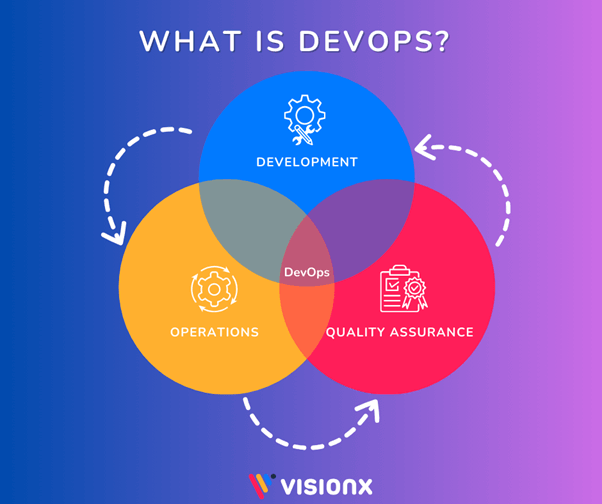Software development and IT operations are essential for business success in today’s digital age. The traditional approach of having separate development and operations teams is no longer enough to keep up with technological advancements.
DevOps is a methodology that focuses on collaboration, automation, and continuous delivery to streamline the entire software development lifecycle.
In this article, we will explore the world of DevOps and its benefits for businesses of all sizes.
What is DevOps?
DevOps is a combination of development and operations in the software development domain.
DevOps is an approach to software development and IT operations that emphasizes collaboration, automation, and continuous delivery.
It involves breaking down silos between development and operations teams and using tools and processes to automate the entire software delivery lifecycle.
The goal of DevOps is to enable organizations to deliver high-quality software faster, with greater confidence and reliability.

The Key Goals of DevOps
DevOps is a methodology that seeks to improve the collaboration and communication between development and operations teams to deliver high-quality software faster and more efficiently.
The key goals of DevOps are as follows:
- Faster Time to Market
DevOps aims to reduce the time it takes to deliver software to customers by streamlining the development and deployment process.
- Improved Quality of Software Releases
DevOps emphasizes the use of automation and continuous integration and delivery to improve the quality of software and reduce the risk of defects.
- Increased Efficiency of Teams
By automating repetitive tasks and breaking down silos between teams, DevOps aims to increase the efficiency and productivity of development and operations teams.
- Customer Satisfaction
DevOps aims to deliver high-quality software that meets customer needs, leading to increased satisfaction and loyalty.
The Benefits of DevOps
DevOps offers numerous benefits. Some of them include:
- Reduced Lead Time for Changes
By automating and streamlining the development and deployment process, DevOps enables organizations to respond quickly to market demands and customer needs.
- Increased Deployment Frequency
DevOps enables faster delivery of new features and functionality, allowing organizations to stay competitive in a rapidly changing environment.
- Faster Mean Time to Recovery
DevOps emphasizes the importance of resilience and the ability to recover quickly from incidents or outages, reducing the impact on customers.
- Improved Collaboration among Teams
DevOps breaks down silos between teams and creates a culture of shared responsibility, leading to more effective problem-solving and improved morale.
What is the process of DevOps?
DevOps consists of a set of processes and methodologies that prioritize automation and agility with the main goal of accelerating application production.
The key focus of DevOps is centered around automation and agility. The process of DevOps comprises the following steps:
1. Development
Continuous Development is a term often associated with DevOps. The development phase of the process involves coding and development of the software or application. It includes tasks such as writing code, designing the software architecture, and creating the necessary features and functionalities.
2. Building and Integration
In this phase, the developed code is compiled, built, and integrated with other components of the software. This step ensures that all the individual pieces of code work together seamlessly.
3. Testing
The testing phase involves the validation of the software to ensure that it meets the specified requirements and functions as intended. This includes various types of testing such as unit testing, integration, integration testing, and system testing.
4. Feedback and Monitoring
This phase involves gathering feedback from users, stakeholders, and automated monitoring systems to understand how the software is performing and to identify any areas of improvement.
5. Delivery
The delivery phase focuses on packaging the software and preparing it for deployment. This may involve creating installation packages or container images that can be easily deployed to various environments.
6. Deployment
Deployment is the process of releasing the software into production or making it available for use by end-users. This phase involves installing the software on servers or making it accessible through cloud platforms for users to access and utilize.
Best Practices for DevOps in 2024
1. Security Integration Throughout the Lifecycle
In 2024, integrating security throughout the software development lifecycle is crucial. DevOps teams should prioritize security at every stage, from code development to deployment.
Implementing security measures such as automated vulnerability scanning, secure code reviews, and continuous security testing can help identify and address potential security risks early in the development process, ensuring the final product is secure and resilient.
2. Embracing AI and Machine Learning
DevOps teams should embrace AI and machine learning technologies to optimize and automate various aspects of the software development lifecycle.
From predictive analytics for identifying potential issues to intelligent automation for repetitive tasks, incorporating AI and machine learning can enhance efficiency, accuracy, and decision-making within DevOps processes.
3. Continuous Performance Optimization
In 2024, DevOps should include a focus on continuous performance optimization. This involves monitoring application and infrastructure performance in real-time, identifying areas for improvement, and implementing optimizations to enhance speed, scalability, and reliability.
By continuously fine-tuning performance, DevOps teams can ensure that applications meet the evolving demands of users and the market.
4. Infrastructure as Code (IaC) Implementation
Implementing Infrastructure as Code (IaC) involves using declarative or imperative code to automate the provisioning and management of infrastructure.
This approach enables teams to define and manage infrastructure resources in a repeatable and consistent manner.
By using IaC, organizations can achieve greater efficiency, reduce the risk of manual errors, and ensure that infrastructure configurations are standardized across different environments, such as development, testing, and production.
5. Continuous Monitoring and Feedback Loop
Establishing continuous monitoring and feedback mechanisms is crucial for identifying potential issues timely.
Organizations can promptly address any issues by implementing these mechanisms, ultimately improving overall system performance and reliability.
This proactive approach not only helps in maintaining system stability but also in preventing potential disruptions.
Conclusion
DevOps is a methodology that emphasizes collaboration, automation, and continuous improvement to deliver high-quality software with greater speed and efficiency.
DevOps’s key goals and benefits are closely intertwined, leading to improved customer satisfaction, faster time to market, and increased efficiency and productivity of teams.
By integrating security throughout the software development lifecycle and following best practices, DevOps teams can further enhance the effectiveness and reliability of their processes in 2024 and beyond!
